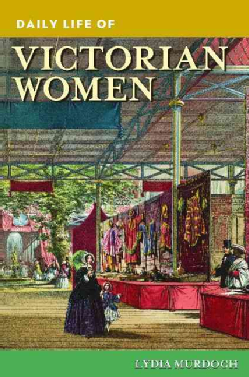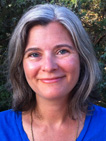Posted on behalf of Molly James, Library Research Department Intern
As many of you know, March is Women’s History Month, a commemoration that sprang from International Women’s Day (March 8), whose origins go back to the early twentieth century. It’s the perfect time to catch up with Vassar Professor of History Lydia Murdoch and learn more about her most recent book, The Daily Life of Victorian Women, and her research practices in general.
Q: Could you please explain your field and your current research?
A: I am a historian of modern Britain and I teach courses that extend from the 17th century into the 20th century. My main expertise is on the 19th century and I am primarily a cultural and social historian. That means I’m interested in the daily life of people and questions of identity. I do a lot of work with gender and the family and the history of childhood in particular. I also teach classes on imperialism and the British Empire and I teach a seminar on the First World War- a range of things.
Q: The Daily Life of Victorian Women is your most recent book. What type of research did you conduct for it and where did you do it?
A: The book is a survey on a huge topic, divided thematically with chapters on estate, religion, family, health and sexuality, childhood, education, urban life, and empire. So the research was very different from anything I’d done before – much broader, more synthetic research, looking at scholarship produced in the last 20 years about women, gender and sexuality, all these questions to create a text that has the most recent research in it.
I also included a lot of selections of primary historical documents. For those, the research was in primary works, and I was able to do most of it at Vassar using our amazing library resources. We have incredible databases for the 19th century to find journal articles, including C19 for British periodicals, government documents, and abolitionist pamphlets, a lot of them written by women’s organizations. We have The London Times and The Times of India full text online, and these were essential documents for me to be able to use.
Research librarians, Gretchen Lieb and Carol Lynn Marshall, who work very closely with me as liaisons for Women’s Studies and History, were amazing. Rachelle Ramer, our Science Librarian, is helping me with my most recent project. Barbra Durniak helped me with some complex interlibrary loan requests. I used more popular sources for The Daily Life of Victorian Women, and although most of the research I could find through Vassar, there were pamphlets I couldn’t find here or in other places, but by using interlibrary loan I was able to get copies of them. Vassar’s library has a wonderful collection of materials for the 19th century.
Q: How often do you go to England for your research?
A: It really depends, varying on my own life cycle. When I was a graduate student I went and lived there for a whole year. Now I try to go back during the summers.  One of the reasons I agreed to do the textbook, The Daily Life of Victorian Women, was because it was harder for me to travel. I needed something I could do while I was based here. Last summer I went to England for research and for a conference, and I plan to go back this summer for two weeks. It’s a very different research experience partly because of my stage of life and technology. As a graduate student I would go and sit, read everything, and synthesize while in the archives. I still think that’s a great luxury and allows, in some ways, more in depth engagement with the sources. Now when I’m there I’ll scan and copy and photograph documents as fast as I can and bring them back home to analyze.
One of the reasons I agreed to do the textbook, The Daily Life of Victorian Women, was because it was harder for me to travel. I needed something I could do while I was based here. Last summer I went to England for research and for a conference, and I plan to go back this summer for two weeks. It’s a very different research experience partly because of my stage of life and technology. As a graduate student I would go and sit, read everything, and synthesize while in the archives. I still think that’s a great luxury and allows, in some ways, more in depth engagement with the sources. Now when I’m there I’ll scan and copy and photograph documents as fast as I can and bring them back home to analyze.
Q: Where do you go for your research?
A: I go to a mix of archives. One of the key places I go is the British Library, in the main library’s manuscripts room, where I work quite a bit with manuscripts and diaries. I also work in what’s called the India Office Records, because I do imperial history. That’s where all the official East India Company records are. They have an amazing photographic image collection. I also go to the main archives in the Greater London Record Office, which is now called the London Metropolitan Archives, again a wonderful place to work in London because it has all the government records. Last summer I went there to look at coroner records to trace child mortality, illness, vaccination, medical issues, and medical histories. I’m excited this summer to start works at an archive called The Women’s Library Archive. It recently moved; it’s now at London School of Economics. It’s a great resource for women’s history and women’s records.
I’m certainly interested in longstanding issues in gender, women, and childhood. I was looking at materials for this book about child mourning and child death and was looking at one of the most popular movements of the 19th century, the anti-vaccination movement. In the India Office Records of the British Library I found documents regarding children in India being used to spread the smallpox vaccine. The children used for these campaigns were drawn from what were called orphanages, but the children weren’t full orphans. The records described that the main method for transmitting vaccine matter was to infect one child and have the pus develop in the pox and take from that pus to literally infect another child consecutively. To transmit vaccine over long distances, by sea and by land, they needed children. I found these records describing children in the Bengal lower orphan school, which was for primarily mixed race children, who often had native mothers and fathers from the East India Company. I tried to look at how what is described as the greatest humanitarian liberal reform of the early 19th century, spreading vaccination and saving a tremendous number of lives through this technology, was also built on the hierarchies of colonialism, race, class, parentage.

